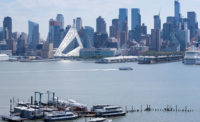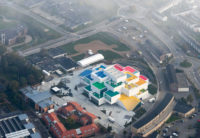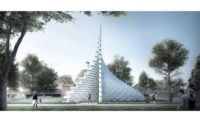Until Hurricane Irma hit on September 10, the most striking aspect of the Grove at Grand Bay in picturesque Coconut Grove, south of Miami’s downtown, was the unconventional twisting form of the two condominium towers. Now attention is focused on how well the pair (among others) survived 100-mile-an-hour winds and a 4-foot storm surge. “Overall, the two structures did extremely well—including their hurricane-impact glass,” reports Jason Gilg, senior development manager with the project’s Miami-based developer, Terra.
With its design, the Danish firm Bjarke Ingels Group (BIG) jettisoned the typical rectilinear high-rise and a straightforward, gridded plan. Instead, the firm conceived of two 20-story residential buildings of reinforced concrete where floor plates rotate as they rise from the second to the 17th level, capturing the views of Biscayne Bay. The tight three-acre site on which a hotel once stood posed a challenge to BIG: only the short end of the property faces the ocean, and zoning restrictions affect building height and setbacks. The answer was to place the 99 luxury apartments in twin towers.
Additional Content:
Jump to credits & specifications
The only problem was that it would be hard for the apartments in the north tower to have the same views as those in the south one, which is closer to the water, unless something unusual occurred. By swiveling the floors two-thirds of the way up and giving the south tower a square footprint that was smaller than that of the rectangular north one, the architects could provide spectacular views to almost all the occupants. (Only seven smaller units don’t have water views.) In addition, open-plan apartments with 12-foot-high ceilings make you feel as if you are sailing on a large yacht. And when you step onto one of the deep, cantilevered balconies that can extend out as much as 12 feet, it’s as if you are perched on a tall mast overlooking the marina and the bay beyond.
Yet Terra knew that the water views and the location—historically an artsy enclave of bungalows, overgrown with palms and banyan trees—were not enough in a competitive market. Amenities—including a spa for adults and a spa for pets—also were not enough. The design had to be distinctive to attract a sophisticated, super-affluent clientele, for apartments that average 4,000 square feet. Terra wanted a high-flying architect.
BIG, known for its startling, large-scale formal gestures, such as the looping 8 apartment house in Copenhagen or the pyramidal Via 57 West in New York, was a natural choice. (Terra also commissioned Rem Koolhaas’s firm OMA to design the three-tower Park Grove close by. Now nearing completion, it is also a hardy survivor of Irma.)
The angled scheme that firm principal Bjarke Ingels came up with has the dynamic quality of his previous work, but is more elegant in its expression of excitement. It helps that the firm was involved with the design of certain interiors, including the lobby, which features crisp, custom metal-paneled ceilings, white oak cabinetry, and contemporary modern furniture. Furthermore, the developer cared about finishes: when the interior’s exposed concrete turned out to be grotty in places, the company brought in German artisans to refine the surfaces.
The landscaping around the towers and on the roof of the coiled, concrete entrance canopy, which links the two lobbies, adds to the sense of luxe. Miami-based landscape designer Raymond Jungles has created an homage to the Brazilian Roberto Burle Marx at the Grove. While some of Jungles’s swirling extravaganza of native trees and plants were lost to Irma’s brute power, they should be replaced soon.
One of the most impressive aspects of the project—especially in light of “Irmageddon”—is the engineering. BIG’s rotational scheme presented a huge challenge to DeSimone Consulting Engineers. On the floors that twist, DeSimone and BIG agreed that 30-inch-diameter concrete columns placed for the most part at the perimeter, should slant diagonally. If they were left as vertical supports, says Ingels, they would “have ended up in weird locations. This way, they tilt, but occupy the same location on each floor.” And rather than hiding them and “diminishing the drama,” he adds, “we left the columns exposed to look like art pieces.”
But with this concept, the team had to mitigate the torsional forces resulting from the sloping columns while countering hurricane wind loads. “We would have needed 6-foot-thick concrete shear walls at the elevator core,” says Abdul Mohammad, senior project manager for DeSimone. Since Terra wanted the maximum real estate, worth about $1,200 per square foot in sales, the engineers came up with a composite core of concrete and steel internal plates for the shear walls, keeping them at 30 inches thick.
To further reduce torsional forces, the team created a hat truss for each roof, where girders are cantilevered from the tower cores and connected to the columns. They in turn are suspended in tension at the uppermost levels. Other measures were taken to add more stability to the complex. For example, to reduce building movement, the floor plates are cambered, or slightly arched, in relation to the floor below. Because of soft soil conditions for the heavy loads, the engineers installed scores of pressure-injected auger-cast piles, averaging 80 feet in depth, below the three-story podium and its two levels of parking. Since the property is located in a flood zone, they also inserted a post-tensioned hydrostatic basement slab, useful in facing Irma.
Fortunately, the client was committed to the extra outlay of money for this kind of endeavor. Terra calculated that even if the costs for the $400 million project were more than 18 percent over normal construction expenses, the hefty prices of the condos—$3 million to $25 million—would cover cost overruns. (All, except for one penthouse, have been sold.)
Besides its sense of luxury, Grove can claim LEED Gold status. Measures involve reducing the use of potable water for irrigation by almost 80 percent and having heating and cooling systems rely on high-efficiency chillers and variable-speed exhaust. At least 30 percent of the materials are recycled or locally sourced.
While the ravages of Irma took their toll, the episode demonstrated that the extra investments were worth it. “In engineering, everything is possible,” says Mohammad. The interaction between architects and engineers proved to be an impressive example of collaboration, with one side dreaming up a challenging concept and the other making it work and taking it to another level. The result is a graceful work that appears effortless—and even stands up in high winds.
CreditsArchitect: BIG-Bjarke Ingels Group, 61 Broadway, Suite 3300, New York, NY 10006, +1 347-549-4141, www.big.dk
Personnel in architect's firm who should receive special credit: Partners in charge: Bjarke Ingels, Thomas Christoffersen Project Leader: Leon Rost Project Manager: Ziad Shehab Team: Beat Schenk, Jenny Chang, Brian Foster, Ed Yung, Jitendra Jain, Tiago Barros, Terrence Chew, Ji-young Yoon, Ho Kyung Lee, Kasper Hansen, Greg Knobloch, Chris Malcolm, Cat Huang, Martin Voelkle, Maureen McGee, Chris Falla, Taylor McNally-Anderson, Alana Goldweit, Mina Rafiee, Valerie Lechene, Chris Gotfredsen, Aaron Hales, Bennett Gale, Haochen Yu, Hongyi Jin, Iannis Kandyliaris, Maureen Rahman, Rakel Karlsdóttir, Thomas Juul-Jensen
Architect of record: Nichols Brosch Wurst Wolfe & Associates, Inc
Interior designer: Esrwe + Cadena Thinc.
Engineers Civil: VSN Engineering, Inc Structural: DeSimone Consulting Engineers M/E/P: Hufset-Nicolaides-Garcia-Suarez Geotechnical: Langan Engineering & Environmental Services Wind: RWDI (Rowan Williams Davies and Irwin, Inc)
Consultants Elevator: Lerch Bates, Inc LEED: The Spinnaker Group, Inc Landscape: Raymond Jungles, Inc.
General contractor: Facchina Construction of Florida, LLC
Photography: Rasmus Hjortshøj; Robin Hill |
SpecificationsExterior Cladding Balconies (materials): Concrete with Thermocromex Podium (materials): Concrete, Oolite Natural Florida Stone Cladding, Florida Keystone Pavers
Glazing Glass: Vitro; Tecnoglass (fabrication)
Interior Finishes Resilient flooring: Forbo Linoleum Wood cladding: Ebony and Co, Mafi, Dinesen, Proteak, Maderas Finas, Mafi Wood block flooring: Kaswell Stone flooring: Larry's Caprock and Stone
Furnishings Residential kitchen appliances: Miele Residential laundry appliances: Electrolux Specialty kitchen casework: Snaidero
Plumbing Residential water closets, urinal, bidets: Duravit Residential lavatories and sinks: Hansgrohe, Duravit Residential bathtubs: Duravit Residential faucets, supplies, trim: Hansgrohe, Dornbracht, Duravit |

















Post a comment to this article
Report Abusive Comment